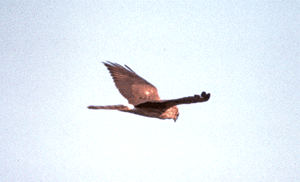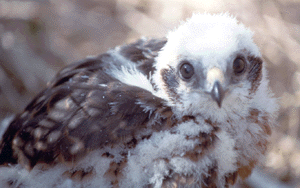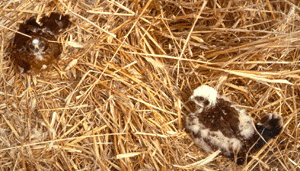

The Montagu's Harrier (Circus pygargus) is a day-time bird of prey which belongs to the family of the accipitrid.
The species has a clear sexual dimorphism: the male, smaller, has a cinder-gray body with black on the tips of its wings which can resemble a seagull from a distance; the female has a brown upper body and a lower body the color of a chamois with dark borders. A typical characteristic of the female is the white upper part of the tail.
It is a very visible species and somehow unique for the environment it frequents: big open spaces like that of a steppe, pastures or cereal crop fields. It also has a big wing-span which enables it to spend most of the time in flight.
In Italy it is a regular migratory and nesting species which arrives in the nesting areas in mid April and then returns south at the beginning of August.

The numerical consistence of the Italian population is estimated to be between 250 and 300 couples with typical annual fluctuations of the species.
The Viterbo area represents one of the most southern districts for nesting on the Tyrrenean side of Italy. The aggregations are localized near Montalto di Castro, Tarquinia, Tuscania and Monteromano with about 30 couples.
It hunts primarily while in flight exploring the terrain at a low altitude, often surprising the prey behind natural obstacles like bushes and lower ground levels.
Its diet varies a lot in its habitat giving this species an eclectic aspect. In its reproductive period it hunts small mammals, ground sparrows (for example the Skylarks), small reptiles and big insects. Studies done in Europe show that in the Montagu's Harrier's diet there are 43% of small mammals. This piece of information shows the fundamental role the bird has in agricultural environments in its control of rodents.

The Achilles' heel of this species is represented by a particular reproductive behavior. This can be seen in its distribution and in the choice of its nesting area. The couples in fact, do not spread themselves homogeneously on the territory, but form small aggregations of about 2-6 couples.
In this way a common territory for nesting is formed. In the case of intrusion by predators, see Black kite or Hooded crow, which feed on the eggs and the young, the territory is defended by all the adults.
If steppes and prairies are absent the Montagu's Harrier has chosen corn fields as a nesting ground.
In the Viterbo area 65% of it nests in wheat fields, 21% in hay fields, 14% in barley fields, and rarely in uncultivated terrains.
Three to five eggs are laid in simple nests on the ground. In the Viterbo area this occurs in late April and the beginning of May. Sometimes it is possible to have late replacements of the laid eggs up until mid June.
The eggs are attended for by the female which is nourished by the male for the whole period of incubation. It seems that the male is not capable of feeding the young.
After about five weeks the young are ready to fly and they start following their parents to learn the hunting techniques.
This reproductive behavior causes in Lazio tragic consequences due to the fact that the reaping period anticipates that of the first flights of the young birds.
This situation is not the same in the whole Italian area or in Europe because the number of couples which nests in uncultivated fields has grown and many times different climatic conditions can postpone the reaping period.
In the Lazio region there is the concrete need to save every year tens of youngs Montagu's Harriers from certain death. Apart from emotions which one might feel in these cases, there is a serious risk of extinction for this population which every year loses 60% of its nests.
For this reason since 1981 a research program has been created. It is finalized in estimating the state of conservation of the Montagu's Harrier in Italy and the limiting factors impacting on the population productivity.
A special commitment was made in the protection of those nests in danger. Accords with category associations have been made to make farmers aware of the problem.
For the Viterbo area the G.U.F.O. gives its technical contribution every year, individualizing the nesting sites, making the farmers aware of the problem, and spreading information around regarding this situation.

The aim of the Albanelle Project is to increase the reproductive success of the species, contributing to maintain the animal's biodiversty. On the site, there is an attempt to find the nesting areas by following the courtship of the animal. Where necessary a 4 square meter area of ground is fenced to leave the young an area large enough for their first flight attempts.
It is fundamental to make the farmers aware of the problem and to compensate them for their lost grounds.
If you would like to participate in these trips send a e-mail message to Stefano at albanelle@gufo.org with your phone number. If you are in Viterbo you can pass in Aula Studenti of the FacoltÓ of Agraria, where there is the Association's billboard, and you can see when the trips take place.

Gruppo
Universitario Faunistico Ornitologico
(Universitary Group for Wildlife and Ornithology)
Viterbo